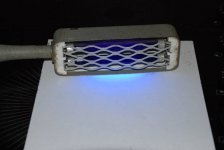Hey there IC! Shouts to Jump and AA!
I've been using a small 50 led blacklight flashlight to check my extracts for solvents lately, and am curious as to others results, especially with regards to absolute amber...How thick a cake are you able to purge fully with your current method? Does it reflect any iridescence when exposed to UV? What about your amber?
In my tests what I had thought to be fully purged honeycomb BHO (5-10g mounds, 1/8" thick when spread into piles 3-4" across) actually contains slight levels of solvents visible with UV light, while matter that I am able to press thinner purges successfully...I purge at 120 degrees for a few hours in mason jars vac sealed with a seal-a-meal on small squares of parchment..Looking for a way to get my larger, prettier bho cookies to be UV neutral..
While I am able to produce fully purged BHO, after winterizing I am unable to get the final product UV neutral..It solidifies to a state that will shatter into bits when dropped on the ground and is fully stable to the touch, yet elicits a deep iridescence under UV...No matter what I do I can't seem to purge all of the ethanol from the material..any suggestions?
I think UV testing is the way to go for all purging, but don't see many other people discussing it...What does everybody else think?
I run my amber at 180-200 degrees for 30 minutes after the last of the visible alcohol boils away, didn't have my vac chamber for this batch but spreading it thin after collection is quite difficult as the amber seems to solidify in seconds...I purge on a pie pan over water w/ a laser pen to check temperature..I think vac purging will help, but spreading the collected matter thin is tough! Maybe a larger pressure vessel where I can simply place my pie pan inside so I can vacuum purge without collecting (and balling up) the AA?
A couple photos follow, first set is AA showing green iridescence. second is a smaller fully purged BHO honeycomb blob, third is a larger BHO honeycomb showing iridescence due to incomplete purging.
Curious to see what everybody else thinks.





_UberMan_
I've been using a small 50 led blacklight flashlight to check my extracts for solvents lately, and am curious as to others results, especially with regards to absolute amber...How thick a cake are you able to purge fully with your current method? Does it reflect any iridescence when exposed to UV? What about your amber?
In my tests what I had thought to be fully purged honeycomb BHO (5-10g mounds, 1/8" thick when spread into piles 3-4" across) actually contains slight levels of solvents visible with UV light, while matter that I am able to press thinner purges successfully...I purge at 120 degrees for a few hours in mason jars vac sealed with a seal-a-meal on small squares of parchment..Looking for a way to get my larger, prettier bho cookies to be UV neutral..
While I am able to produce fully purged BHO, after winterizing I am unable to get the final product UV neutral..It solidifies to a state that will shatter into bits when dropped on the ground and is fully stable to the touch, yet elicits a deep iridescence under UV...No matter what I do I can't seem to purge all of the ethanol from the material..any suggestions?
I think UV testing is the way to go for all purging, but don't see many other people discussing it...What does everybody else think?
I run my amber at 180-200 degrees for 30 minutes after the last of the visible alcohol boils away, didn't have my vac chamber for this batch but spreading it thin after collection is quite difficult as the amber seems to solidify in seconds...I purge on a pie pan over water w/ a laser pen to check temperature..I think vac purging will help, but spreading the collected matter thin is tough! Maybe a larger pressure vessel where I can simply place my pie pan inside so I can vacuum purge without collecting (and balling up) the AA?
A couple photos follow, first set is AA showing green iridescence. second is a smaller fully purged BHO honeycomb blob, third is a larger BHO honeycomb showing iridescence due to incomplete purging.
Curious to see what everybody else thinks.
_UberMan_




